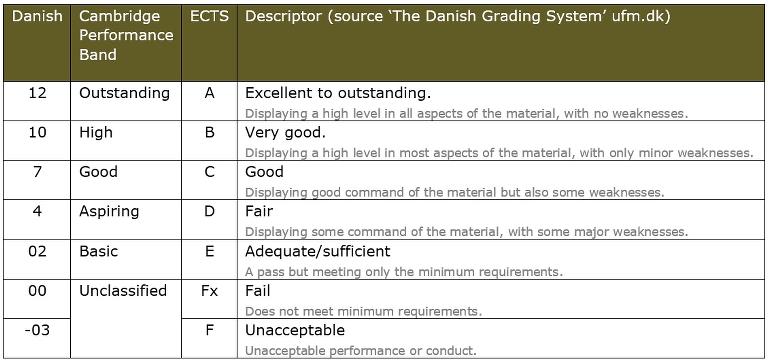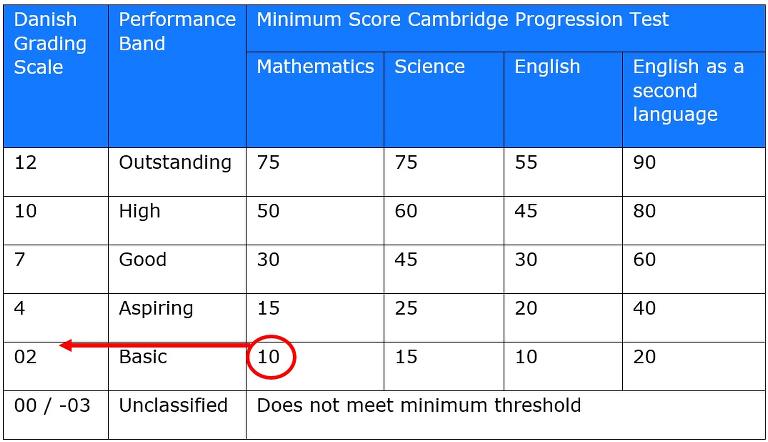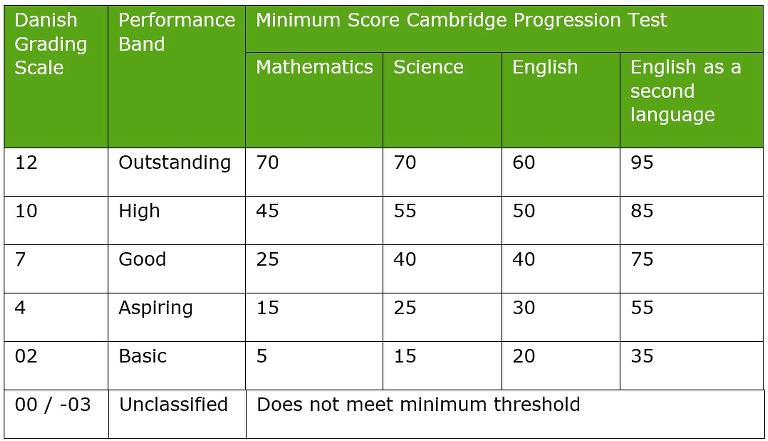Grading and assessment
Grade 9 exams
Students complete their schooling with us at the end of Grade 9 with leaving exams, typically in May and June, followed by a graduation event at the end of June.
There are six exams:
- English
- Mathematics
- Science
- Danish
- Optagelseprøve (High school entrance exam)
- Global Perspectives project assignment.
English, mathematics, and science are Checkpoint 9 written exams from Cambridge International Education. These exams are in English designed for a native-level English speaker. Global Perspectives is a group or individual assignment and oral presentation. These exams are compulsory.
The FP9 Danish exam consists of spoken and written components designed by the Danish Ministry of Education. Optageslseprøve is the high school entrance exam which assesses basic knowledge in Danish, English, mathematics, and science. These exams are in Danish and are compulsory if the student has attended LIS for two or more years.
Grade comparison chart
The first column shows the seven-point Danish grading scale. When students begin to receive grades, they will be given feedback according to the Danish grading scale. The next column shows Cambridge Performance Bands followed by the European ECTS scale. The last column provides descriptors to better understand what the grade represents. A passing grade is a 02.

Cambridge Progression Tests and mock exams
Cambridge Primary Progression Tests are teacher-marked assessments that can be taken at any point during a school year for a given stage. Grade 8 and Grade 9 sit progression tests in a more formal mock exam setting. The raw score on a progression test, or mock exam, is used to determine the minimum threshold required to achieve each of the performance bands for the Cambridge Progression Tests. The thresholds required to achieve each performance band are generally different for different subjects and exam series. This is because the thresholds take account for the difficulty of the tests. Performance bands are calculated from the mean and standard deviation of Cambridge candidates world-wide. Easier tests will have higher thresholds than harder tests.
The thresholds follow something similar to a bell curve, meaning very few from the class will achieve the extremes, therefore, the majority of students will achieve 'good', with fewer falling in the other bands.
For example: A grade 6 pupil achieves a raw score of 13 out of 100. Using the table below, that score equals ‘basic’ (as the next threshold of 15 has not been reached). This equates to 02 on the Danish Scale. This is a passing grade.
Cambridge Primary Progression Test (Grade 3-6)

Cambridge Lower Secondary Progression Test/Mock Exam (Grade 7-9)

No. Cambridge (and the UK) uses a 6 point scale while Denmark (and Europe) use a 7-point scale. They do not match perfectly. There are overlaps, for example a Cambridge progress test result may fall in across the 4 and 7 Danish grade. Teacher makes a judgement on which is most accurate based on the descriptor.
No. Cambridge says there is no simple relationship between the number of raw marks that learners achieve and a grade based on percentage. “After Cambridge papers have been moderated, we use an established statistical technique called Rasch analysis to process the marks. This analysis produces a score which takes into account the difficulties of the questions.” (cambridgeinternational.org)
The tables above show that different raw marks are needed to achieve a given performance band than in other subjects. Why is this? Different tests, difficulties, and mark schemes may require more to demonstrate ‘Good’ than in other tests and subjects. For example, English as a Second Language tests require learners achieve a higher raw score raw to reach each performance band than they do in other subjects because the test includes multiple-choice questions.


